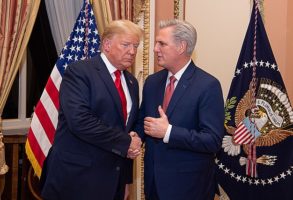
Published January 12, 2017
The Weekly Standard - January 16, 2017 issue
A big federal investment in infrastructure is one of the few things that Donald Trump has specifically said he wants to pursue early in his presidency. It is not as high a priority for most congressional Republicans, to put it mildly.
In fact, their work so far on the coming legislative year suggests that House and Senate leaders hope they might push infrastructure off the agenda by getting started early on health care and tax reform. Two major initiatives, both pursued through reconciliation bills (the failure to pass a budget resolution in 2016 allows for two reconciliation measures in 2017), would already make for an unusually intense legislative year. A third major initiative, even though it would involve different committees and coalitions, would not be easy to squeeze in—particularly as a new president without experience in pressing his priorities in Congress gets his sea legs.
And yet, precisely because the congressional Republicans’ two key priorities are both set to be pursued through essentially partisan reconciliation bills, it may be hard to avoid an infrastructure bill. The new administration will want to do something with the Democrats, and infrastructure offers the prospect of a bipartisan measure that could furnish ribbon-cutting photo opportunities for years to come. It will also be the foremost priority of Gary Cohn, whom Trump has appointed to lead his National Economic Council. That means an important portion of the White House staff will press the issue.
In both respects, infrastructure could be for the Trump team what No Child Left Behind was for George W. Bush in his first year: The Bush team prioritized the bill’s bipartisan potential above any policy particulars, and Bush’s domestic policy adviser, Margaret Spellings, was especially committed to it.
The analogy should worry congressional Republicans. So to avoid getting stuck with a choice between voting for a sopping legislative mess or opposing one of the foremost priorities of a new president of their own party, those Republicans need to be thinking about what a reasonable infrastructure measure might look like. At the very least, they need an approach of their own to reinforce the case for opposing a bad bill.
And they must do that in full recognition of two particular dangers to be avoided. The first is simply the danger of wasting lots of money on pork and on projects unlikely to contribute much to the state of America’s infrastructure. Many conservatives in Congress are well aware of that danger. It’s why they are not excited about a big infrastructure bill. But the second distinct risk of infrastructure legislation is less obvious. Simply put, moving carelessly toward an infrastructure package could cost conservatives the earmark ban they worked so hard for a few years ago.
The ban is already in a precarious state. House Republicans were set to vote on whether to renew it in late November, and their leadership had to step in and “delay” the vote into this year—because it seemed suddenly like there might be a majority in the conference in favor of bringing back earmarks. The party’s leaders aren’t all opposed to ending the ban themselves, but they knew that the conference wasn’t ready for the political shock that an unexpected vote to do so would have involved. Putting a large pot of infrastructure money on the floor would surely strengthen the desire to bring back earmarks and could well render it irresistible.
Conservatives therefore will need an alternative, not just resistance. What would that look like? A plausible approach could involve three elements, each geared to economic growth and the efficient use of public resources: reforming permitting rules, alleviating key bottlenecks in the transportation system, and otherwise devolving decisions about project spending to states and localities.
The first is a form of deregulation, and one that has garnered a fair bit of bipartisan backing in recent years. Significant infrastructure projects are now routinely held up for years in the federal permitting process, rendering both public and private infrastructure spending less effective and contributing enormously to the backlog of essential projects.
Congress has tried to address the problem, most recently through the Fixing America’s Surface Transportation (or FAST) Act enacted at the end of 2015. And the Obama administration actually tried a series of administrative measures to take on the problem too. All of these, however, have tended to focus on consolidating the review process to enable better oversight. That’s a good idea, to be sure, and there are further steps along those lines that would make sense: Alaska senator Dan Sullivan has proposed requiring the permitting agencies to provide approvals or denials within a set period of time, for instance, so that if the time limit were exceeded the project would be deemed approved.
But beyond finding ways to accelerate all the permitting that’s now required, Congress should also cut down on the requirements—for instance, reducing the range of environmental concerns that require review under the National Environmental Policy Act and allowing such reviews to build on those conducted for similar projects in the past, rather than beginning from scratch with every application. Aggressively reducing federal permitting requirements would act as a multiplier of whatever else was done in an infrastructure bill, far better enabling federal, state, and local infrastructure spending to actually make a difference and thereby also encouraging more investment.
Second, in thinking about projects to be funded, congressional Republicans should prioritize the easing of bottlenecks in America’s transportation infrastructure. And they should focus on bottlenecks in the movement of goods before those in the movement of people.
This is not how politicians naturally incline to think about throwing money at construction projects, of course. But precisely because of how the political system tends to approach infrastructure, there is some relatively low-hanging fruit to be picked when it comes to major bottlenecks in the movement of cargo. Antiquated rail tunnels around Baltimore, for instance, create major choke points with huge implications for how goods move up and down the East Coast—and they also add to the number of trucks on highways, slowing the movement of people. The rail networks that converge in Chicago confront similar bottlenecks that create huge costs and delays.
America’s inland waterways, which are essential to our freight-transportation system, feature similar choke points begging to be addressed. And as with rail bottlenecks, an unusual number of them are in the Midwest, which Republicans with their eyes on electoral dynamics naturally find themselves much interested in after this election. The country’s major seaports could also benefit from some upgrades that have enormous potential to spur growth.
Those kinds of projects are what public (and particularly national) investments in infrastructure ought to emphasize. Their purpose should be, like the government’s role in a market system more generally, to help our economy function more effectively, enabling competitive markets in ways those markets are unlikely to take up themselves.
The movement of cargo isn’t more important than passenger transportation, but it’s less likely to already have a political constituency behind it, particularly at the state and local level. And it is also often (though not always) less likely to involve infrastructure upgrades that could readily be paid for by user fees, tolls, or other sources of profits for builders and investors, and so might require some public funding to spur action. These kinds of needs can be harder to see, and the ways in which people involved in politics tend to personally experience the transportation system can badly distort how government funds infrastructure. Someone who describes a new passenger-rail tunnel into Manhattan as a high national priority is likely to be someone who frequently travels to and from Manhattan and needs a broader definition of “national.” To the extent that infrastructure spending is determined at the national level, it should focus on genuinely national needs with the potential to spur the growth of the national economy.
But of course, most infrastructure spending shouldn’t be determined at the national level, because needs and priorities differ in different parts of our vast country. Therefore, if conservatives are going to offer support for new infrastructure legislation, the third element of any proposal they offer should involve setting the country on a course toward devolving more infrastructure policy toward the state and local level, where most of it belongs.
For instance, as a number of conservatives in Congress have proposed in recent years, such legislation could significantly reduce the federal gas tax and allow states and localities to hike it back up to the degree they desire, raising revenue (while their residents only pay as much in taxes at the pump as they do now) for transit, roads, pipes, and other infrastructure projects better prioritized by policymakers closer to the ground.
States should also be allowed to establish new tolls on the Interstate Highway System, which they can do today only by building specialized new lanes or by begging the Transportation Department for hard-to-get exemptions. More generally, a new infrastructure bill should try to define in some bounded way the federal role in infrastructure policy. The lack of clear boundaries on this front, as in so many areas of contemporary federalism, is an enormous obstacle to effective public policy at all levels.
A bill with these three elements would stand some chance of advancing conservative priorities while meeting Donald Trump’s stated objectives. It would still be likely to waste a fair bit of public money. And it wouldn’t guarantee the survival of the earmark ban, which faces real peril in the new Congress. But on net, it could trade some temporary spending for more enduring structural changes in our infrastructure policy, while trying to focus that spending as well as possible.
That is the kind of approach that conservatives should look to more generally in contending with Trump administration initiatives that aren’t up their alley. There will surely be many opportunities to advance conservative proposals in the coming years. But there will also be many instances when conservatives need to resist and restrain and to approach the new president transactionally. That will mean prioritizing structural reforms and the reinforcement of constitutional boundaries over more ephemeral policy questions where necessary. Infrastructure offers a good place to start.
Yuval Levin is a contributing editor to The Weekly Standard, Hertog fellow at the Ethics and Public Policy Center, and editor of National Affairs.








